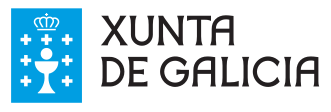Article Index
INTRODUCTION
The Silicon Tracker of the LHCb experiment consists of silicon strip detectors with a pitch of around 200 µm. For the Trigger Tracker station upstream of the magnet, a 500 µm thick sensor with 512 strips is used, while the three Inner Tracker Stations after the magnet feature 320 and 410 µm thick sensors of 384 strips each. The signals are amplified and processed by the Beetle readout chip, which transmits its data via differential analogue lines to the Service Boxes. Here, the signal is digitised and converted into an optical signal, which is transmitted via fiber of up to 120 m length to the counting house to an optical receiver card, which is located on the Level-1 preprocessing boards (TELL1). An overview of the transmission side of the readout system is shown in the next figure.

The part of the electronics located in the cavern, which comprises the elements in the service and detector boxes is the so-called "L0 Electronics". The part in the counting house is the "L1 Electronics".
THE SERVICE BOX
While the silicon sensors and the hybrids are located in the service boxes, the digitizing and control electronics is located in the service boxes, out of the detector acceptance. This reduces the amount of dead material and hence multiple scattering and generation of secondary particles. In addition, the location of the Service Boxes, features lower radiation levels and easier access for cooling and maintenance.
Each Service Box holds up to 16 Digitizer Boards, which handle the signals coming from and going to the readout hybrids. As this includes not only the physics data, but also power supply, timing and slow control signals, this allows for a single cable connection between a hybrid and its associated Digitizer Board. For each Service Box, a Control card provides the interface to the experiment-wide Timing and Fast Control system (TFC) and the Experiment Control System (ECS). The distribution of these signals among the Digitizer Board within a Service Box is done with a customdesigned backplane. The backplane also carries the radiationtolerant linear voltage regulators to supply the readout hybrids and the Service Box itself. An overview scheme of a Service Box is shown in the figure below.
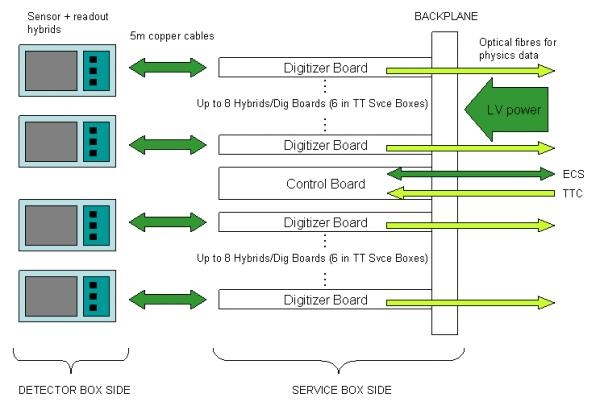
THE TELL1 ELECTRONIS
In the counting house is located the "L1 electronics" whose purpose is the handling L0 accepted databefore transmission to the DAQ. The data are transferred by optical lines from the service boxes to the counting houses. There the TELL1 boards perform deserialization, some data processing, followed by transmission of the compressed data to the L1 and HLT trigger CPU farm.
LOW VOLTAGE AND HIGH VOLTAGE
Besides the acquisiton, digitization, processing and transmission electronics of the L0 and L1 electronics, some electronic infrastructure such as the Low voltage and High voltage voltage power supplies is essential to power the systems.
Although it could seem a trivial task, the proper selection, distribution and installation of the power systems is a crucial for the proper working of the complete detector. This is a part closely related to the grounding and shielding management of the Silicon Tradker detector. The careful design of grounding, shielding and power distribution strategy is essential in big elementary particle detectors.
EXPERIMENT CONTROL SYSTEM (ECS)
The complete Silicon Tracker detector (power supplies, front-end, DAQ, etc.) must be under the control of the Experiment Control System (ECS).
ECS is in charge of the configuration, control and monitoring of all the components of the online system. This includes all devices in the areas of: data acquisition, detector control (ex slow controls), trigger, timing and the interaction with the outside world.
The ECS will be a highly hierarchical and distributed system with a large set of local controllers based on Finite State Machines performing the control and monitoring of specific parts of the detector. The Silicon Tracker ECS must link to the global LHCb ECS implementig some interfaces which have already been defined.
CONTROL BOARD
This card provides the necessary functionalities to carry out several control and monitoring tasks, namely: the slow and fast control of the Silicon Tracker readout and digitizing electronics; control and monitor the LV power regulators; and the monitoring of the detector box temperatures and humidity.
As the structure of the Inner Tracker detector and the Trigger Tracker is very similar but with a different partitioning scheme, a common control board has been designed for both detectors. Next figure shows the basic layout of the ST electronics.
Another requirement that the Control Board (CB) has to meet is that the devices and components on it need to tolerate the radiation levels present in the cavern where the service boxes are located. For this reason some specific radiation hard devices developed at CERN are used. Several devices tested by our group and also other ones tested by other LHCb and CERN groups are used as well.
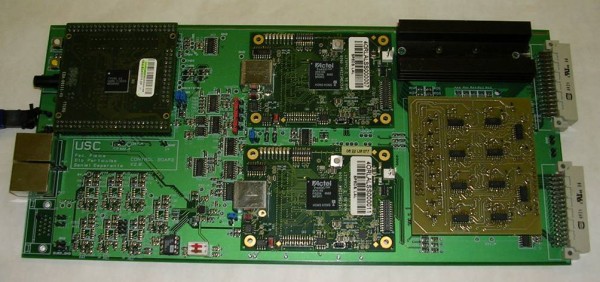
The following figures depict the functional block diagram of the CB, and also show a prototype CB and the blocks physical distribution on it:
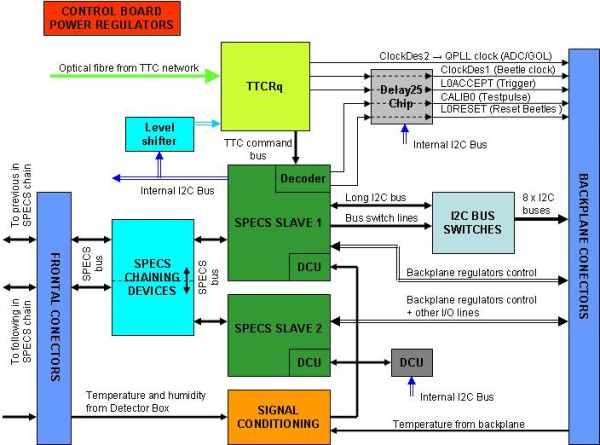
- Power Regulators: 3 LHC491387[3] power regulators for supplying the 2.5V, 3.3V and 5V needed by the CB devices.
- Frontal and backplane connectors:
-
The frontal connectors consist of:
-
1 SubD high density connector for the detector box environmental monitoring.
-
RJ45 connectors for the SPECS[1] chain connection.
-
An AMP/Tyco 6 pin row connector for monitoring the IT half station position switches.
-
-
The backplane connectors are 2 half size DIN 41612
-
- TTCrq: the TTCrq[2] is mezzanine card developed by the CERN microelectronics group containing the TTCrx and other associated components such as a pin-preamplifier and a QPLL.
-
TTCrx: An ASIC receiver developed for the LHC Timing, Trigger and Control (TTC)[4] distribution system. The ASIC implements an interface between the front–end electronics and the TTC system making the TTC coding and multiplexing schemes transparent. The receiver delivers the LHC timing reference signal, the first level trigger decisions and its associated bunch and event numbers. It can be programmed to compensate for the propagation delays associated with the detectors and their electronics. The IC supports the transmission of data and of synchronised broadcast commands.
-
A connectorized PIN photodiode with a trans-impedance amplifier for the reception of the TFC signals from the optical TTC network. Radiation tested.
-
QPLL: Phase-Locked Loop based on a Voltage Controlled Quartz Crystal Oscillator (VCXO). Its function is to act as a jitter-filter and clock multiplier for clock signals operating at the LHC bunch-crossing frequency (40.08 MHz). The device is implemented in a 0.25 µm CMOS technology using radiation tolerant layout practices.
-
- Delay25 chip: it is a 5 channel CMOS programmable delay line featuring 4 channels that allow phase delaying of periodic or non-periodic digital signals and a master channel that can be used to phase delay a clock signal. The master channel serves as a calibration reference. The phase of each channel can be independently programmed with a resolution of 0.5 ns through an I2C interface. The reference clock frequency can be any of the following: 32, 40, 64 or 80 MHz.
- SPECS slaves: These are two mezzanine cards[1] hosted in the CB developed for interfacing electronic devices to the Experiment Control System. The SPECS System is composed of a PCI master card (typically located in the control room faraway form the nasty radiation environment) which can address several SPECS slave mezzanines. The heart of the mezzanines is a radiation tolerant FPGA, but it also contains a radiation hard ADC (the DCU) and some radiation tolerant LVDS drivers and receivers for driving the SPECS communication to the master. Three standard interfaces are provided by the SPECS Slave to control the components on the board or at distances of up to 10 meters: I2C, JTAG and a (simple) parallel bus (only directly on the board), from which we only use the I2C.
- SPECS chaining devices: it is a compendium of LVDS drivers and receivers implemented in the CB for chaining many SPECS slaves in the same SPECS master link. This chaining mechanism is both used for interconnecting the 2 SPECS slaves in the CB and also for interconnecting with other CBs.
- Signal conditioning devices: wheatstone bridges and instrumentation amplifiers used for conditioning the temperature and humidity signals.
- DCU: a radiation hard ADC[5] used for sampling the humidity signal and some others.
- I2C bus switches: a mezzanine card whose purpose is demultiplexing the “SPECS fashion” long I2C bus into 8 individual open collector compatible I2C buses. These I2C buses are necessary for controlling all the Beetles in the Detector Boxes and the GOLs and DCUs in the digitizer boards. A detailed description of the partitioning and I2C address assignment is show later.
- Level shifter: it consists of 2 bipolar transistors working in saturation mode [6] which allow for translating the 2.5V I2C generated by the SPECS slave into 3.3V necessary for TTCrq voltage compatibility.
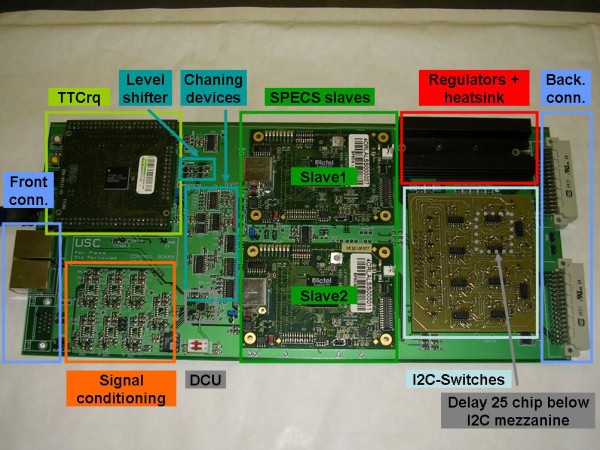
It is also of special interest the clock and TTC signal distribution. The TTCrq delivers the two clocks needed for the Beetles and the sampling electronics (clockDes1 and clockDes2), the trigger signal (L0ACCEPT) and the TTC command bus from which the L0Reset and the calibration signal are decoded. The L0RESET and the TESTPULSE signal (CALIB0) are decoded in the SPECS FPGA and the decoding of the latter can be delayed by the SPECS from 0 to 16 cycles of 25ns. All these signals but the clockDes2 pass through the Delay25 chip so they can be phase delayed within a range of 32ns in steps of 0.5ns, therefore a fine tuning of its timing is possible.
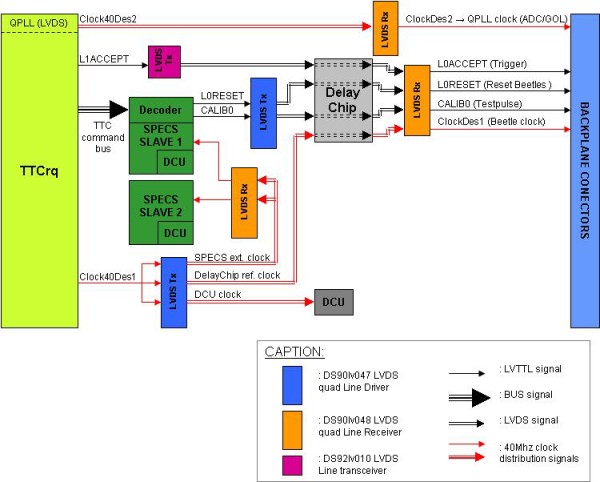
-
-
1 SubD high density connector for the detector box environmental monitoring.
-
RJ45 connectors for the SPECS[1] chain connection.
-
An AMP/Tyco 6 pin row connector for monitoring the IT half station position switches.
-

